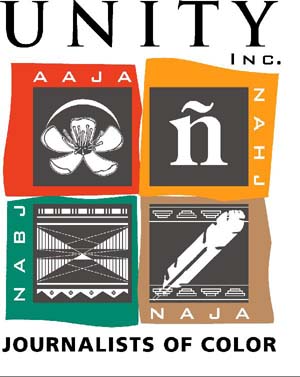 I’m disappointed that the National Association of Black Journalists (NABJ) is pulling out of Unity, a partnership of journalists of color with the National Association of Hispanic Journalists (NAHJ), Native American Journalists Association (NAJA) and Asian American Journalists Association (AAJA — full disclosure: I’m the president of the Denver chapter of AAJA).
I’m disappointed that the National Association of Black Journalists (NABJ) is pulling out of Unity, a partnership of journalists of color with the National Association of Hispanic Journalists (NAHJ), Native American Journalists Association (NAJA) and Asian American Journalists Association (AAJA — full disclosure: I’m the president of the Denver chapter of AAJA).
It’ll diminish the power of next year’s Unity convention, which is slated for Las Vegas. The four Unity orgs have gotten together every four years for a combined confab since 1994.
My introduction to both AAJA and Unity was an inspiring convention in 2004 in Washington DC, when both then-President Bush and presidential hopeful John Kerry spoke to the gathered attendees. Kerry got a noticeably more robust welcome from the assembled journalists of color, which was noted in the mainstream media.
I also attended the 2008 Unity convention in Chicago, where candidate Barack Obama spoke. Both conventions were great learning experiences, and emotionally powerful experiences as well, for just being part of a large group of people of color.
I attend the AAJA conventions in between the Unity years, and they’re great and inspirational too. But there’s something amazing about seeing 8,000 or so journalists of color — all colors — in one place.
Veteran newspaper journalist and AAJA member Emil Guillermo wrote a cogent blog post about NABJ’s move today, and it’s worth reading.
I understand the NABJ’s gripes. They wanted a bigger cut of the split from the Unity conventions because they bring more than half the attendees to every Unity. They also figured out they’d make more money if they just planned their own confab next year somewhere else.
But it diminishes both the appeal and the effectiveness (in networking to pick just one obvious example) of a Unity convention if the biggest contributor decides not to attend the party. It might beg the question of why a separate Unity structure, with its own staff and executive director and budget, needs to be funded by the remaining organizations.
Then we’re left in our separate silos, even if the NABJ says they’ll continue to work towards the unified goal that all of these orgs share. And when we’re divided, we may not have the same clout in the industry (not that that’s helped — numbers for minority journalists are down in newsrooms for the third year straight).
Like Guillermo’s blog post headline says, “Journalists of color run out of unity.â€
That’s a shame.










